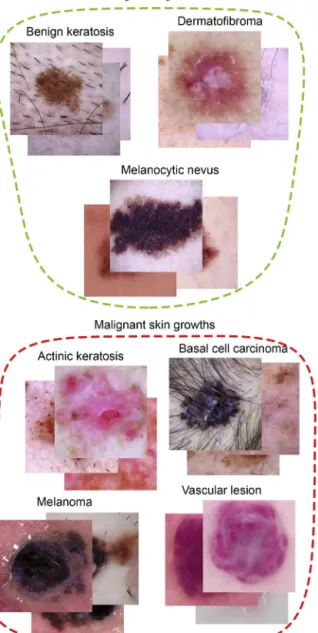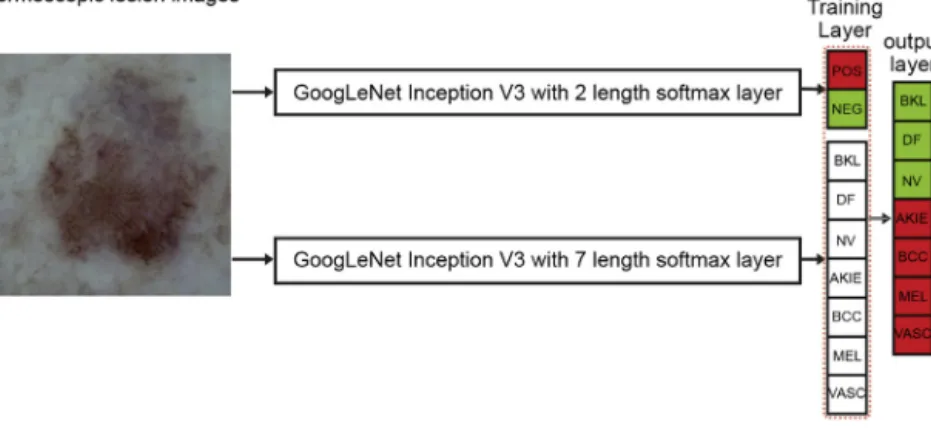ContentslistsavailableatScienceDirect
Biomedical Signal Processing and Control
j ou rn a l h o m e p a g e :w w w . e l s e v i e r . c o m / l o c a t e / b s p c
Assisted deep learning framework for multi-class skin lesion classification considering a binary classification support
Balazs Harangi
∗, Agnes Baran, Andras Hajdu
FacultyofInformatics,UniversityofDebrecen,POB400,4002Debrecen,Hungary
a r t i c l e i n f o
Articlehistory:
Received1November2019 Receivedinrevisedform9April2020 Accepted5June2020
Keywords:
Assistedlearning Deeplearning Ensemblelearning Skinlesion
a b s t r a c t
Inthispaper,weproposeadeepconvolutionalneuralnetworkframeworktoclassifydermoscopyimages intosevenclasses.Withtakingtheadvantagethattheseclassescanbemergedintotwo(healthy/diseased) oneswecantrainapartofthenetworkregardingthisbinarytaskonly.Then,theconfidencesregarding thebinaryclassificationareusedtotunethemulti-classconfidencevaluesprovidedbytheotherpartof thenetwork,sincethebinarytaskcanbesolvedmoreaccurately.Forboththeclassificationtasksweused GoogLeNetInception-v3,however,anyCNNarchitecturescouldbeappliedforthesepurposes.Thewhole networkistrainedintheusualway,andasourexperimentalresultsontheskinlesionimageclassification show,theaccuracyofthemulti-classproblemhasbeenremarkablyraised(by7%consideringthebalanced multi-classaccuracy)viaembeddingthemorereliablebinaryclassificationoutcomes.
©2020ElsevierLtd.Allrightsreserved.
1. Introduction
Skin cancer is a common and locally destructive cancerous growthoftheskin.Itoriginatesfromthecellsthatlineupalong themembranethatseparatesthesuperficiallayeroftheskinfrom thedeeperones.Aspigmentedlesionsoccuronthesurfaceofthe skin,malignantbehavior(e.g.melanoma)canberecognizedearly viavisualinspectionperformedbyaclinicalexpert.Dermoscopyis animagingtechniquethateliminatesthesurfacereflectionofthe skin.Byremovingsurfacereflection,morevisualinformationcan beobtainedfromthedeeperlevelsoftheskin.
In thelast fewyears thecomputer aideddiagnosis (CAD)is becomingmoreandmoreimportantinskincancerdetection[1].
Asaffordable mobiledermatoscopesare gettingavailabletobe attachedtosmartphones,thepossibilityfor automatedassess- mentisexpectedtopositivelyinfluencecorrespondingpatientcare forawidepopulation.Giventhewidespreadavailabilityofhigh- resolutioncameras,algorithmsthatcanimproveourabilitytoasses suspicionslesionscanbeofgreatvalue.
Thereis along termhistory of computeraideddermoscopy imageanalysisandthusitsliteratureisveryverbose.Thecommon protocolistoapplysomepre-processingforimageenhancement andartifactremovalandthenperformclassificationbasedoncer- tainextractedfeatures[2].Thecurrenttrendistoconsiderdeep
∗Correspondingauthor.
E-mailaddress:harangi.balazs@inf.unideb.hu(B.Harangi).
learningfeaturesasbeingsuperioroverhand-crafted,orclinically inspiredones[1,3].Toextractdeeplearningfeaturesseveralconvo- lutionalneuralnetwork(CNN)systemshavebeenconsidered.As forbackboneCNNarchitecturesthecurrentlymostpopularones areResNet[4]andGoogLeNet[5].
Skin lesions can be categorized in numerous classes, how- ever, themain practical taskof the clinician is todifferentiate betweenmalignant and benign lesions,sothe cardinal issueis torecognize theirmalignancy, thatis, tobeabletolabelthem asbenign/malignant(healthy/diseasedornegative/positive)ones.
Sincebenign/malignantappearancesareusuallysufficientlydiffer, thebinaryclassificationtaskcanbesolvedwithhigheraccuracy than the multi-class one in this field [6]. Moreover, if we can technically merge someclasses intoone, we have a chance to increasethenumberoftrainingsamplesbelongingtothetwodif- ferentclasseswithoutusinganyaugmentationtechniqueswhich canalsoresultinhigheraccuracy.Based ontheseobservations, inthis paperweproposea CNNarchitecture,which issimulta- neouslytrainedtosolveabinaryandamulti-classclassification problem,wherethetwoclassesofthebinarytaskrepresentthe benign/malignantclassesoftheoriginal7-classskinlesionclassifi- cationproblem.Ourmethodologicalcontributionistoincorporate thehigheraccuracybinarylevelclassificationconfidencetosup- portthefinalmulti-classlabeling.Naturally,ourapproachhadto berealizedinsuchawaythatsupportstheefficienttrainingofthe CNNarchitecturein thecommonwayviabackpropagation.Our mainmotivationwastodemonstratethepotentialimprovement ofexploitingthehigherclassificationaccuracyonsmallernum-
https://doi.org/10.1016/j.bspc.2020.102041 1746-8094/©2020ElsevierLtd.Allrightsreserved.
Table1
Numberofimagescorrespondingtothe7classesintheHAM10000trainingset.
Classes CNV CMEL CBCC CAKIE CBKL CDF CVASC
Samplesize 6705 1113 514 327 1099 115 142
berofmergedclassesinamulti-classscenarioandourempirical resultshavejustifiedtheseexpectations.In[7,8],atypeofassisted learningwasintroducedforemotionrecognition.Thebinaryclas- sificationoutcometheredeterminedthefurtherallowedlabelsin themulti-classproblem,whichisbasicallyaclassicdecisiontree- basedmethod.Oppositetothisapproachweproposeanetwork architecturethatembedsbinaryclassificationinthetrainingpro- cess.Theconnectedconvolutionalneuralnetworkslearntogether simultaneouslyandsettheirparametertooptimizethecommon lossfunctionattheensemble-systemlevelbasedonthedeveloped mathematicalbackground.
Therestofthepaperisorganizedasfollows.InSection2,we describeournovelmethodologywithpresentingfirsta7-classskin lesiondataset.We introduce ournetwork architecturetogether withtheproperformaldescriptionofapplyingbinaryclassification supportduringtraining.Our experimentalresultsarepresented fortheISIC2018 challengedatainSection3.We discussonour hardwareandtraining setupsinSection4and alsoonhowthe proposedbasicmodelcanbeimprovedfurthertoincreaseitscom- petitivenessinskinlesionclassification.Finally,inSection5some conclusionsaredrawn.
2. Proposedmethodology 2.1. Data
TheorganizersofthechallengeInternationalSkinImagingCol- laboration(ISIC)2018:SkinLesionAnalysisTowardsMelanoma Detectioncalledforparticipationindevelopingefficientmethods toclassifyskinlesionimagesintosevenclasses.Namely,theimages arelabeledaccordingtothefollowingclassesofskinlesions:
•CBKL:benignkeratosis(solarlentigo/seborrheickeratosis/lichen planus-likekeratosis),
•CDF:dermatofibroma,
•CNV:melanocyticnevus,
•CAKIE:actinickeratosisorBowen’sdisease,
•CBCC:basalcellcarcinoma,
•CMEL:melanoma,
•CVASC:vascularlesion.
OurdatawasextractedfromtheISIC2018:SkinLesionAnalysis TowardsMelanomaDetectiongrandchallengedatasets[9,10].The ISIC2018challengehasreleasedanimagesetcollectedbyTschandl etal.[9]attheDepartmentofDermatologyoftheUniversityof Viennaandat theCliff Rosendahlin Queensland,Australia.The authorsclassifiedthecollectedimagesintosevengenericclasses becauseofsimplicityandthereasonthatmorethan95%ofthe lesionsappearinginclinicalpracticefallintooneofthesevendiag- nosticcategories[9].Thepublisheddatasetcontains10,015images fortraining,193forvalidation,and1512fortestingpurposes.The trainingsetconsistsofimageswithmanualannotationsregard- ingthesevendifferentclassesinthefollowingcompounds:6705 imageswithnevuslesions,1113withmalignantskintumors,514 withbasalcellcarcinoma,327withactinickeratosis,1099withany benignkeratosis,115dermatofibromaand142oneswithvascular lesions.Thenumberofimagesregardingtheseclassestriestofol- lowtheprevalenceoftheclassesinthepopulation,aswell.Table1 summarizesthenumberofimagesintheHAM10000training-set
Fig.1.Thedistributionoftheimagesbetweentheclassesinthetrainingsetof HAM10000.
accordingtodiagnosisand Fig.1 depictsthedistributionofthe imagesamongtheclasses.
Thenumberofimagesinthecertainclasses(excludethenevus one)isnotsufficientlylargefortrainingdeepCNNs.Toincrease thenumberoftrainingimageswithalsoavoidingtheover-fitting ofthenetworkandreducingthedifferencesbetweentheamount ofimagesinthedifferentclasses,wehavefollowedthecommonly proposedsolution[11]fortheaugmentationofthetrainingdataset, suchascroppingrandomsamplesfromtheimagesorhorizontally flippingor rotatingthem atdifferentangles. We alsonotethat heretheaugmentationstrategiestoincreasethesizeofthetrain- ingdatasetneedtobeappliedaftercarefullyunderstandingofthe problemdomain.Itmeansthatinordertoavoidanymodificationof thecharacteristictextureofdifferenttypeoflesionswecouldnot usearbitraryscalingoraspect-ratiochangeswhicharetypically used.Astheresolutionoftheimagesinthedatasetare450×600 pixels,buttheappliedCNNarchitecturesoriginallyrequireinput imageofspatialresolution299×299,werandomlycroppedsub- imageswiththerequiredsizefromtheoriginaloneinsteadofusing scaling.Moreover,ontheseextractedimagesweappliedrotating withrandomlyselectedanglefromtheset[90◦,180◦,270◦]andhor- izontal/verticalflipping.Inordertocreateamoreheterogeneous datasetweappliedrandombrightenandcontrastfactorswhichare usedtosetthebrightnessandthecontrastoftheimagesrandomly.
Usingtheseprocedures,wehavegeneratedthesemodifiedtrain- ingimagesandincreasedtheoriginalnumberofthesampleimages forthemelanoma(4452),basalcellcarcinoma(4626),actinicker- atosis(4251),benignkeratosis(4396),dermatofibroma(2415),and vascularlesionclasses(2982).
The seven classes C1, ..., C7 of skin lesions can be further groupedasnegative/positive(benign/malignant)onesas
CNEG =CBKL∪CDF∪CNV,
CPOS =CAKIE∪CBCC∪CMEL∪CVASC. (1) Withthisformulationwecansetupabinaryclassificationproblem besidestheoriginalmulti-class(7-class)one.Ourmotivationwith addingthebinaryclassificationproblemtotheoriginaloneisthat wecantakeadvantageoftheoutputofthebinaryclassifiertomake afinerlabelingaccordingtothe7classes,sincethesimplerbinary task(wherethenumberoftrainingsamplescorrespondingtothe differentclassesislarger)canbesolvedmoreaccurately.Foran impressionof thecharacteristicsofthelesionsbelongingtothe sevenclasses,seealsoFig.2.
2.2. Networkarchitecture
Asforthedesignofournetworkarchitecture,ourmainmoti- vationwastoletthemorereliablebinaryclassifiertoinfluence
Fig.2.Sampleimagesfordifferenttypesofskinlesions.
theoutputofthemulti-levelone.Asbackbonearchitecturesfor both the binary and multi-class classifiers we have considered GoogLeNetInception-v3 [12],asGoogLeNetisreportedtoshow asolidperformance inskinlesionclassification[3].Ascommon requirementsofdesigning deepconvolutionalarchitectures,we alsohadtotakecareabouttoincorporatesuchfunctionalelements thatsupportstrainingviaefficientbackpropagation.Consequently, wehad toinvolveafunction,whose derivativecanbegiven in closedformtodescribetheinfluenceofthebinaryclassifier.
Torealizetheaboveaims,wehaveconsideredtheGoogLeNet Inception-v3pre-trainedmodelonImageNet [13]anditslayers havebeenfine-tunedintwotimes;onceforthebinaryandonce forthe7-classtask.Then,thesetwofine-tunedmodelshavecom- posedintoonenetworkarchitectureasshowninFig.3.Namely,the proposednetworkcanbedividedintotwomainCNNbrancheswith oneofthemisdedicatedtobinary,whiletheotherformulti-class classification.Thus,thetwobranchesresultinrespective2Dand 7Dsoftmaxlayers,whicharemergedinaSupportTrainingLayer (STL).Then,asthelastlayerofthenetworka7Dsoftmaxlayeris consideredtoaddresstheoriginalmulti-classclassificationprob- lem.AttheSTLlayer,theprobabilityvaluesfoundbythebinary classifierusedtorefinethecorrespondingmulti-classprobabilities
viakeeping/droppingthem(CASEI)orviaasimplemultiplication (CASEII).Moreformally,letussupposethatattheSTLlayerwe have classconfidencespNEG and pPOS withpNEG+pPOS=1by the binary, while pBKL+pDF+pNV+pAKIE+pBCC+pMEL+pVASC=1 by the multi-classclassifier regardingthecorrespondingclasses.More- over,let[p]=round(p)denotetheroundoperator,whichprovides 0or1forboththebinary/multi-classprobabilities.Then,thecon- fidencevaluesforthefinal7Dsoftmaxlayerarecalculatedas:
•CASE I: [pNEG]*pBKL, [pNEG]*pDF, [pNEG]*pNV, [pPOS]*pAKIE, [pPOS]*pBCC,[pPOS]*pMEL,[pPOS]*pVASC,
•CASEII:pNEG*pBKL,pNEG*pDF,pNEG*pNV,pPOS*pAKIE,pPOS*pBCC, pPOS*pMEL,pPOS*pVASC
withaconsequentnormalizationtosumthemupto1inbothcases.
TointerpretbetterthedifferencesbetweenCASEIandII,notice that,withCASEIwebasicallyfollowa classicdecisionrule/tree model[7,8]withexcludingtheclassescorrespondingtothebinary classhavinglowerconfidence;technically,theroundoperatorpro- videsa 0multiplieraccordingly. Asa refinedapproach,CASE II followsamoredynamicwaybytuningonlythe7-classconfidences withthebinaryones.ThoughinourexperimentsCASEIIhasledto aremarkableimprovement,wealsoenclosetheperformanceof theCASEIapproachasourinitialattempt.Ineithercase,foreffi- cientcomputationwehadtobeabletoembedourapproachinthe commontrainingprotocolbybackpropagation,whosedescription isgivennext.
2.3. Trainingwithbackpropagation
Inordertocodethepartofthebackpropagationcorrespond- ing tothe STLwe have tocompute thederivatives of the loss functionwithrespect totheinputdataof thislayer.For a for- maldescription,letx=(x1,...,x9)∈R9 betheinputoftheSTL layer,wherex1=pNEG,x2=pPOSarethecorrespondingconfidence resultsofthebinaryclassifier,whiletheremaining7coordinates x3=pBKL,x4=pDF,x5=pNV,x6=pAKIE,x7=pBCC,x8=pMEL,x9=pVASCof xdescribethefinalprobabilitiesprovidedbythe7-classCNNclas- sifierbranchofthenetwork.Whenz ∈R7istheoutputoftheSTL layer/thewholenetwork,andListhelossfunction,thenwehave tocomputethederivatives ∂L
∂xi,i=1,...,9.InCASEIIduringthe forwardpassthevectorziscalculatedas
z=(x1x3,x1x4,x1x5,x2x6,x2x7,x2x8,x2x9)T. (2) Tocalculatetherequiredderivatives,wecanusethechainrule:
∂L
∂xi=
7 j=1∂L
∂zj
∂zj
∂xi, (3)
hence
∇xL=
⎛
⎜ ⎜
⎜ ⎜
⎜ ⎜
⎜ ⎜
⎜ ⎜
⎜ ⎜
⎜ ⎜
⎜ ⎜
⎜ ⎜
⎜ ⎜
⎝
x3 x4 x5 0 0 0 0 0 0 0 x6 x7 x8 x9
x1 0 0 0 0 0 0
0 x1 0 0 0 0 0
0 0 x1 0 0 0 0
0 0 0 x2 0 0 0
0 0 0 0 x2 0 0
0 0 0 0 0 x2 0
0 0 0 0 0 0 x2
⎞
⎟ ⎟
⎟ ⎟
⎟ ⎟
⎟ ⎟
⎟ ⎟
⎟ ⎟
⎟ ⎟
⎟ ⎟
⎟ ⎟
⎟ ⎟
⎠
∇zL, (4)
Fig.3.TheCNNarchitectureofourassistedtrainingmethodology.
where∇xLand∇zLdenotethegradientsofLwithrespecttoxand z.
InCASEI–usingthepreviousnotations–thevectorzisgiven by
z=([x1]x3,[x1]x4,[x1]x5,[x2]x6,[x2]x7,[x2]x8,[x2]x9)T. (5) Sincethederivativeoftheroundfunctionis0everywherebutat 0.5,weobtainthatthepartialderivativesofLwithrespecttox1and x2willbeequalto0.Itmeansthatinthiscasethebinaryclassifieras thepartofthewholenetworkcannotbetrained.Inotherwords,the binaryclassifierbranchofthesystemwillremainfixedduringthe wholetrainingprocess,whichlendsalessflexiblecharacteristics forCASEI.Asaminortechnicalissue,noticethat,thederivativeof theroundfunctiondoesnotexistat0.5,however–similarlytothe samephenomenonforReLU–,thisevenoccurswith0probability.
3. Experimentalresults
Inthissection,wesummarizeourexperimentalfindingswitha specialmotivationtoseethebinaryclassificationassistanceonthe multi-classpredictorforbothCASEIandII.Tobeabletoobserve theimprovementbythissupport,wegivethequantitativeresults fortheinitialmulti-classclassifierwithoutbinarysupport,aswell.
Wewillstartourpresentationwiththisoriginalsetup.
Themodelsareevaluated onthetestsetconsisting of1512 imagesprovidedbytheISIC2018challengeorganizers.Theeval- uationshave beenperformedontheofficialchallengewebsite according to the performance measures prescribed there. The submittedsolutionsareprimarilyrankedregardingthebalanced multi-class accuracy (BMA) which is a commonly used mea- sureinmulti-classclassificationproblemsconcerningimbalanced datasets.BMAisdefinedastheaveragesensitivityvalueobtained forthe7classes.Moreover,ascommonperformancemeasureslike accuracy(ACC),sensitivity(SE),specificity(SP),positivepredicted value(PPV)and areaunderthereceiveroperatingcharacteristic curve(AUC)correspondingtoeachindividualclasshavebeencal- culated,aswell.
Forthesakeofcompleteness,weenclosethedetailedresults ofthemodelswithpresentingalsotheirconfusionmatrices.Here, thediagonalelementsrepresentthenumberoftruepositivecases for each class normalized by thecardinality of the given class (a.k.a.sensitivity),whiletheoff-diagonalentriesaretothoseele- mentsthataremislabeledbythegivenclassifier.Sincetheofficial challengewebsitedoesnotsupportthistypeofperformanceevalu- ation,wehaveconsideredthe20%oftheaugmentedtrainingsetfor validation(5964images)tocomputetheseconfusionmatrices.This isthereasonwhythesensitivityfiguresofthemodelsregardingthe differentclassesslightlydifferinthetablesandthecorresponding
Table2
7-Classclassificationresultswithoutbinarysupport.
ACC SE SP PPV AUC
CBKL 0.879 0.825 0.888 0.552 0.942
CDF 0.985 0.545 0.998 0.889 0.937
CNV 0.832 0.802 0.877 0.908 0.933
CAKIE 0.973 0.163 0.997 0.583 0.908
CBCC 0.966 0.731 0.981 0.716 0.981
CMEL 0.874 0.573 0.912 0.454 0.877
CVASC 0.988 0.571 0.998 0.870 0.994
BMA 0.602
Fig.4. Confusionmatrixof7-classclassificationresultswithoutbinarysupport.
confusionmatrices.However,thisisindeedaminortechnicalissue, sincethetrendsnaturallycoincide.
3.1. Resultswithnobinaryclassificationsupport
Thesimplestattempttoaddressthisspecific7-classskinlesion classificationtaskistoconsiderasinglebackboneCNNnetwork withafinalsoftmaxlayerof7D.Asforourcurrentspecificarchi- tectureitcanberealizedwithrestrictingthenetworkshownin Fig.3toitslowerbranch–asingleGoogLeNetInception-v3with 7-classoutput–only.TheBMAofthismodelhasbeenfoundtobe 0.602withtheadditionalperformancemeasuresarealsoshownin Table2foreachclass.Toprovideamorecomprehensiveanalysis thepropercorrespondingconfusionmatrixisalsogiveninFig.4.
Moreover,sincesimplebinary(benign/malignant)classification canbehighlyinformativeforusersofskin-relatedCADsystems,
Table3
Binaryclassificationresultswithmergingthenegative(benign)andpositive(malig- nant)lesionclasses.
ACC SE SP PPV AUC
CNEG 0.949 0.968 0.929 0.935 0.948
CPOS 0.949 0.929 0.968 0.965 0.948
Fig.5.Confusionmatrixofthebinaryclassificationresults.
inTable3weenclosethecorrespondingresults.Noticethatthese binaryclassificationresultsarederivedfrommergingthe7skin lesionclassesaccordingto(1)intoanegative(healthy)andpositive (diseased)class andconsideringtheupperbranchof ourarchi- tecturefromFig.3–asingleGoogLeNetInception-v3withbinary output–forthistask.Forthesakeofcompleteness,theconfusion matrixforthesimplebinaryclassificationsetupisalsogivenin Fig.5.
ThecomparisonofTables2and3reflectsourinitiativetoexploit thebetterbinaryclassificationperformanceinthemulti-classprob- lem.
3.2. Resultswithbinaryclassificationsupport
Nowweturntotheexhibitionofourexperimentalresultscor- respondingtothemainpurposeofthecurrentworkwithincluding binaryclassificationsupportinthemulti-classtask.Tobeableto observethecontinuousimprovementinourapproach,wepresent theexperimentaloutcomesforbothCASEIandIIdescribedinSec- tion2.2,thatis,whenbinarysupportisinvolvedinaratherdrastic way(CASEI)andwhenitisappliedtotunethemulti-classpredic- tions(CASEII).
AsforCASEI,viamultiplyingtheclassprobabilitiesofthe7skin lesionseitherby0or1astheroundedclassprobabilitiesofthe binaryclassifier,wefollowasimple decisiontreelikemodel.In Table4,wepresenttheperformancefiguresregardingthe7-class tasksolvedbythisapproachaccordingtothefinalsoftmaxlayerof thewholenetwork.Formoredetailedcomparativepurposes,we enclosethecorrespondingconfusionmatrixinFig.6,aswell.
ComparingTable4 withTable2 wecan seethat theCASEI approachhasalreadyoutperformedtheoriginalsingleGoogLeNet Inception-v3oneregardingbothitsBMA=0.639valueandtheother measures.Thisresultsuggeststhatlettingonlytheone-directional influenceofthebinaryclassifier tothemulti-classonealone is alreadycapabletoleadtoaslightimprovement.However,notice thatthederivativeoftheroundfunctioniszeroeverywhere(except 0.5),andduringbackpropagationthebinaryclassifierbranchcan-
Table4
7-classclassificationresultsusingbinarysupport(CASEI).
ACC SE SP PPV AUC
CBKL 0.911 0.521 0.976 0.785 0.892
CDF 0.981 0.409 0.999 0.900 0.865
CNV 0.839 0.771 0.940 0.951 0.925
CAKIE 0.977 0.372 0.995 0.696 0.773
CBCC 0.966 0.688 0.984 0.744 0.928
CMEL 0.882 0.602 0.917 0.481 0.889
CVASC 0.991 0.657 0.999 0.820 0.960
BMA 0.639
Fig.6. Confusionmatrixofthe7-classclassificationresultsforCASEI.
Table5
7-Classclassificationresultsusingbinarysupport(CASEII).
ACC SE SP PPV AUC
CBKL 0.925 0.737 0.957 0.741 0.912
CDF 0.983 0.477 0.999 0.913 0.867
CNV 0.874 0.865 0.889 0.921 0.939
CAKIE 0.976 0.326 0.995 0.636 0.827
CBCC 0.971 0.570 0.997 0.930 0.938
CMEL 0.913 0.450 0.972 0.675 0.812
CVASC 0.989 0.571 0.999 0.909 0.924
BMA 0.677
not fine-tune its parameters. Moreover,in that case when the binaryclassifiermissestheclasslabel,thesupportingmodelset eachoutputneuronwhichbelongstooneofthetrueclasslabelsto zero.
Next,wehaveappliedthebinarysupportwithamorerefined wayaccordingtoCASEIIwithkeepingtheoriginalprobabilitiesof thebinaryclassifiertotunethe7-classprobabilities.TheBMAof thismodelaccordingtheofficialISIC2018challengeis0.677.Simi- larlytothepreviouscases,wegivethecorrespondingperformance valuesandconfusionmatrixinTable5andFig.7,respectively.
ComparingTable5(CASEII)withTable4(CASEI),andTable2 (nobinarysupport),wecanclearlyobservethatourinitialpurpose toimprovemulti-classclassificationperformancebythebinaryone isfinallysuccessfullyrealized;overall,wecouldreacha7%raisein balancedmulti-classaccuracy.
Forthesakeofcompleteness,wehavemadesomecomparative resultsregarding some state-of-the-artapproaches which were usedandevaluatedduringtheISIC2018Challenge:SkinLesion AnalysisTowardsMelanomaDetection.Sincethereweremanywell knownCNNsusedasaproposedmethodologyforskinlesionclas- sification,wehaveconsideredthemasstate-of-the-artsolutions
Fig.7. Confusionmatrixofthe7-classclassificationresultsforCASEII.
Table6
ExperimentalclassificationresultsontheofficialISIC2018testset.
Nameofarchitecture BMA
GoogLeNetInception-v3[12] 0.602
GoogLeNet-V3withSTL(CASEI) 0.639
GoogLeNet-V3withSTL(CASEII) 0.677
DenseNet-201astrainedbytheWinnerofChallenge[14] 0.868 DenseNet-201trainedonlyonISIC2018dataset 0.712 DenseNet-201trainedonlyonISIC2018datasetwithSTL(CASEII) 0.734
ResNet-101[4] 0.675
andincludedinthequantitativecomparison.Moreover,toshow thatourproposedmethodcanbeconsideredasageneralframe- workwhichcouldincreaseclassificationaccuracywhenclassesare mergebleinanyway,wehaveinvolvedotherstate-of-the-artCNN architecturesintoourfinalevaluation.Namely,someparticipants usedthepre-trainedResNet-101[4]andDenseNet-201[14]intheir solution.SincebyDenseNet-201superiorresultswereachieved, wehavealsoinsertedthismodelin ourframework tocombine theseven-classesclassifierwiththebinaryclassifierversionusing theproposedsupporttraininglayer.AftertrainingDenseNet-201 ontheISIC2018Challengedataset,wehaveevaluateditsperfor- mancebothwithandwithoutapplyingthebinaryclassifiersupport usingtheISICLive2018.3:LesionDiagnosisautomatedevaluation system.Therespectiveperformancesarealsoincludedinthequan- titativecomparison(seeTable6).AsitcanbeseenfromTable6, theproposedmethodhasremarkablyimprovedthefinalclassifi- cationaccuracyforalltheinvestigatedCNNarchitecturesincluding DenseNet-201,aswell.
4. Discussion
Asforthehardwareenvironment,traininghasbeenperformed onacomputerequippedwithanNVIDIATITANXGPUcardwith7 TFlopsofsingleprecision,336.5GB/sofmemorybandwidth,3072 CUDAcores,and12GBmemory.Theconvolutionalfiltersofthe networkwerefoundbyastochasticgradientdescentalgorithm iteratedthrough21epochstillthevalidationaccuracystartedto dropafterawhileasdepictedinFig.8.Thereasonofthisapproach liesinthefactthatbecauseofthesmallsizeofthedataset,avari- antofGoogLeNetInception-v3pre-trainedonImageNet[13]has beenconsidered,and itslayers have beenfine-tunedonlysep- aratelyfor thebinaryand 7-classtasks.Then, thesepre-trained brancheshadbeenfedintoourassistedtrainingarchitecture.This procedureistheexplanationwhythelearningcurvestartsatquite
Table7
Classificationresultsusingonlythe7-classbranchofthetrainedarchitecture.
ACC SE SP PPV AUC
CBKL 0.917 0.820 0.933 0.672 0.951
CDF 0.983 0.500 0.998 0.880 0.897
CNV 0.880 0.907 0.839 0.895 0.943
CAKIE 0.976 0.395 0.993 0.607 0.855
CBCC 0.972 0.613 0.995 0.891 0.956
CMEL 0.903 0.579 0.944 0.569 0.864
CVASC 0.991 0.657 0.999 0.920 0.996
BMA 0.643
ahighaccuracyinFig.8,thendropsabitbeforethenetworklearns thesupportingphenomenon.Mini-batch sizehasbeenadjusted to100,whilethelearningrateto0.0001;otherlearningrateshas beenalsotested,butiterationfinishedearlierwithloweraccuracy.
Aslossfunctionwehaveselectedcross-entropyasacommonone formulti-classproblems.
Our framework to support finer classification with a rawer onecouldbefurthertunedforthespecifictask.Hyperparameter optimizationisonepossibilitytoincreasetheaccuracy,which– beyondtheclassicCNNparameters(stride,padding,numberoflay- ers/filters,dropoutlevel,etc.)–mayincludeatransformationof thesimpleapproachtomultiplythemulti-classconfidenceswith thecorrespondingbinaryones.Moreover,ensemble-basedsystems areregularlyreportedtoraiseclassificationaccuracy(seee.g.[15]
forthesamefield).Inourmodel,thisapproachcouldberealized withincludingmore –eitherbinaryormulti-class– CNNcom- ponentsandselectaggregationrulesaccordingtotheiroutcomes andtheappropriatewayofprovidingtheassistancebythebinary classifier(s).
Sincetheoriginaltaskwasa7-classclassificationone,wehave notfocusedonthepossibleimprovementofthebinaryclassifica- tionoutcomeemergingthecorrespondingclassesasdescribedin Section2.1.However,noticethatitispossibletorevertthedirection ofthesupportandtoletthe7-classbranchtoassistthebinaryone.
Asfortechnicalrealizationthiscouldbereachedbymultiplying thepNEGandpPOSprobabilitieswiththenormalizedcorresponding 7-classones,sobackpropagationcantakeplace.
Forthesakeofanexhaustiveanalysis,wehavealsoextracted the7-classbranchfromtheSTLlayer;thecorrespondingperfor- mancevaluesareenclosedinTable7.Withthisanalysiswecould check(seeTables2and7)whetherthe7-classbranchwasindeed abletoimproveduringtheassistedtrainingasastandaloneclas- sifier.On theother hand, thewholearchitecture naturally has outperformedits7-classbranchregardingtheclassificationtask (seeTables5and7).
5. Conclusion
Inthispaper,wehaveproposedadeepconvolutionalneural network architecturethat supports multi-class classification by includingthemorereliablebinaryclassificationoutcomeinthe finalclassprobabilities.Torealizethis ideawehavetrainedthe sameCNNarchitecture(GoogLeNetInception-v3)forbothabinary andmulti-classtasksimultaneouslywithmergingtheirsoftmax outputsonasupporttraininglayerwithmultiplyingthemulti-class confidenceswiththecorrespondingbinaryones.Inthisway,we haveachievedaremarkableimprovementina7-classclassification problemregardingskinlesions.
Thereisanaturallimitationforourapproach,namelywhenthe classescannotbemergeddirectlytoasmallernumberofthose.
However,thisissuecanbeaddressedwithapplyingsomenon- supervisedtechniquelikek-meansclustering.Thisapproachcan leadtofurthergeneralizationswithassigningdedicatedbranches inourensembleforeachrecommendednumberofclustersdeter-
Fig.8.Learningcurveregardingtrainingthe7-classclassifierwithabinarysupport(CASEII).
minede.g.bytheelbowmethodink-means.Then,wecanoptimize assistedlearningforthatnumberofclusterscorrespondingtothe specific task. Such ensembles consisting of severalbranches of CNNscanbeoptimizedfurtherwithincludingapenalizationterm inthelossfunctionforcoincidinglabelingtomakethemembers morediversebesideskeepingupoverallclassificationaccuracy.
Authorcontributions
BalazsHarangi:Conceptionanddesign ofstudy,draftingthe manuscript,approvalofthefinalversionofthemanuscript.Agnes Baran:Conceptionanddesignofstudy,draftingthemanuscript, approvalofthefinalversionofthemanuscript.AndrasHajdu:Con- ceptionanddesignofstudy,revisingthemanuscriptcriticallyfor importantintellectualcontent,approvalofthefinalversionofthe manuscript.
Acknowledgement
ResearchwassupportedinpartbytheJanosBolyaiResearch ScholarshipoftheHungarianAcademyofSciencesandtheprojects EFOP-3.6.2-16-2017-00015supportedbytheEuropeanUnion,co- financedbytheEuropeanSocialFund.
References
[1]P.Tschandl,etal.,Comparisonoftheaccuracyofhumanreadersversus machine-learningalgorithmsforpigmentedskinlesionclassification:an open,web-based,international,diagnosticstudy,LancetOncol.20(7)(2019) 938–947,http://dx.doi.org/10.1016/S1470-2045(19)30333-X.
[2]M.E.Celebi,T.Mendonca,J.S.Marques,DermoscopyImageAnalysis,CRC Press,2018.
[3]A.C.FidalgoBarata,E.M.Celebi,J.Marques,Asurveyoffeatureextractionin dermoscopyimageanalysisofskincancer,IEEEJ.Biomed.HealthInform.23 (3)(2018)1096–1109,http://dx.doi.org/10.1109/JBHI.2018.2845939.
[4]K.He,X.Zhang,S.Ren,J.Sun,Deepresiduallearningforimagerecognition, 2016IEEEConferenceonComputerVisionandPatternRecognition(CVPR) (2016)770–778,http://dx.doi.org/10.1109/CVPR.2016.90.
[5]C.Szegedy,P.Sermanet,S.Reed,D.Anguelov,D.Erhan,V.Vanhoucke,A.
Rabinovich,Goingdeeperwithconvolutions,2015IEEEConferenceon ComputerVisionandPatternRecognition(CVPR)(2015)1–9,http://dx.doi.
org/10.1109/CVPR.2015.7298594.
[6]A.Esteva,B.Kuprel,R.A.Novoa,J.Ko,S.M.Swetter,H.M.Blau,S.Thrun, Dermatologist-levelclassificationofskincancerwithdeepneuralnetworks, Nature542(2017)115–118.
[7]X.He,W.Zhang,Emotionrecognitionbyassistedlearningwithconvolutional neuralnetworks,Neurocomputing291(2018)187–194,http://dx.doi.org/10.
1016/j.neucom.2018.02.073.
[8]J.R.Quinlan,Inductionofdecisiontrees,Mach.Learn.1(1)(1986)81–106, http://dx.doi.org/10.1007/BF00116251.
[9]P.Tschandl,C.Rosendahl,H.Kittler,TheHAM10000dataset,alargecollection ofmulti-sourcedermatoscopicimagesofcommonpigmentedskinlesions, Sci.Data5(2018)180161,http://dx.doi.org/10.1038/sdata.2018.161.
[10]N.C.F.Codella,D.Gutman,M.E.Celebi,B.Helba,M.A.Marchetti,S.W.Dusza,A.
Kalloo,K.Liopyris,N.K.Mishra,H.Kittler,A.Halpern,Skinlesionanalysis towardmelanomadetection:achallengeatthe2017international symposiumonbiomedicalimaging(ISBI),hostedbytheinternationalskin imagingcollaboration(ISIC),CoRR(2017),arXiv:1710.05006.
[11]C.Shorten,T.M.Khoshgoftaar,Asurveyonimagedataaugmentationfordeep learning,J.BigData6(1)(2019)60.
[12]C.Szegedy,V.Vanhoucke,S.Ioffe,J.Shlens,Z.Wojna,Rethinkingthe inceptionarchitectureforcomputervision,2016IEEEConferenceon ComputerVisionandPatternRecognition(CVPR)(2016)2818–2826,http://
dx.doi.org/10.1109/CVPR.2016.308.
[13]O.Russakovsky,J.Deng,H.Su,J.Krause,S.Satheesh,S.Ma,Z.Huang,A.
Karpathy,A.Khosla,M.Bernstein,A.C.Berg,L.Fei-Fei,ImageNetlargescale visualrecognitionchallenge,Int.J.Comput.Vision115(3)(2015)211–252, http://dx.doi.org/10.1007/s11263-015-0816-y.
[14]G.Huang,Z.Liu,L.vanderMaaten,K.Q.Weinberger,Denselyconnected convolutionalnetworks,2017IEEEConferenceonComputerVisionand PatternRecognition(CVPR)(2017)2261–2269,http://dx.doi.org/10.1109/
CVPR.2017.243.
[15]B.Harangi,Skinlesionclassificationwithensemblesofdeepconvolutional neuralnetworks,J.Biomed.Inform.86(2018)25–32,http://dx.doi.org/10.
1016/j.jbi.2018.08.006.





